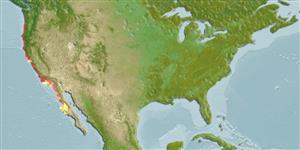Common names from other countries
分类 / Names
俗名 | 同种异名 | Catalog of Fishes(属, 种) | ITIS | CoL | WoRMS | Cloffa
Teleostei >
Perciformes/Zoarcoidei (Eelpouts and pricklebacks) >
Cebidichthyidae (Monkeyfaces)
Etymology: Cebidichthys: Latin, cebus, cebi, derived from caput- itis= head + Greek, ichthys = fish; violaceus: Cebidichthys comes from 2 Greek words: sapajou (a kind of monkey) and fish (hence, monkey fish); violaceus is Latin for violet (Ref. 43439).
More on author: Girard.
Environment: milieu / climate zone / depth range / distribution range
生态学
海洋 居于水底的; 非迁移的 (Ref. 43439); 深度上下限 0 - 24 m (Ref. 51666), usually 0 - 1 m (Ref. 43439). 亞熱帶的; 46°N - 27°N, 126°W - 113°W
Eastern Pacific: southern Oregon, USA to northern central Baja California, Mexico; rare south of Point Conception, California, USA.
東太平洋: 到中北部的墨西哥的下加利福尼亞的美國奧勒岡州南部; 美國加州的 Point Conception 稀有南方。
Length at first maturity / 大小 / 重量 / 年龄
Maturity: Lm 40.6, range 36 - 45.72 cm
Max length : 76.0 cm TL 雄鱼/尚未辨别雌雄; (Ref. 2850); 最大年龄: 18 年 (Ref. 43439)
Common inshore, in tide pools or shallow rocky areas, from the intertidal zone to 24 m depth. May remain out of water under rocks or seaweed (Ref. 31184). Feeds mainly on crustaceans and algae. Breathes air (Ref. 31184) and can remain out of water for 15-35 hours if kept moist (Ref. 51276). Demersal spawners in nearshore habitats (Ref. 56049). Oviparous (Ref. 205). Commonly caught by 'poke-poling', a method using a long bamboo pole with a very short wire leader and baited hook. Good eating.
普遍的沿海地区, 在潮池或浅滩岩石区中, 24 公尺深的从潮间带区域。 可以停留在岩石或海草下面离开水面.(参考文献 31184) 主要吃甲壳动物与藻类。 呼吸空气 (参考文献 31184) 而且能离开水面停留 1535 小时的如果保持潮湿.(参考文献 51276) 在近岸水域的栖息地的底栖产卵鱼.(参考文献 56049) 卵生的.(参考文献 205) 通常被 ' poke-poling' 捕获了, 一个使用一个长的竹子杆的方法具有一个非常短的线头与有诱饵的鱼钩。 好吃。
Oviparous (Ref. 205). Nests in crevices (Ref. 205). A parent coils about the eggs (Ref. 205).東太平洋: 到中北部的墨西哥的下加利福尼亞的美國奧勒岡州南部; 美國加州的 Point Conception 稀有南方。
Eschmeyer, W.N., E.S. Herald and H. Hammann, 1983. A field guide to Pacific coast fishes of North America. Boston (MA, USA): Houghton Mifflin Company. xii+336 p. (Ref. 2850)
CITES (Ref. 128078)
Not Evaluated
人类利用
渔业: 自给性渔业; 游钓鱼种: 是的; 水族馆: 商业性
工具
特别资料
下载 XML
网络资源
Estimates based on models
Preferred temperature (Ref.
115969): 12.2 - 19, mean 15.9 (based on 70 cells).
Phylogenetic diversity index (Ref.
82804): PD
50 = 1.0000 [Uniqueness, from 0.5 = low to 2.0 = high].
Bayesian length-weight: a=0.00389 (0.00180 - 0.00842), b=3.12 (2.94 - 3.30), in cm Total Length, based on all LWR estimates for this body shape (Ref.
93245).
营养阶层 (Ref.
69278): 2.3 ±0.2 se; based on diet studies.
回复力 (Ref.
120179): 中等的, 族群倍增时间最少 1.4 - 4.4年 (tm=4; tmax=18; Fec = 18,000).
Fishing Vulnerability (Ref.
59153): Moderate to high vulnerability (54 of 100).
